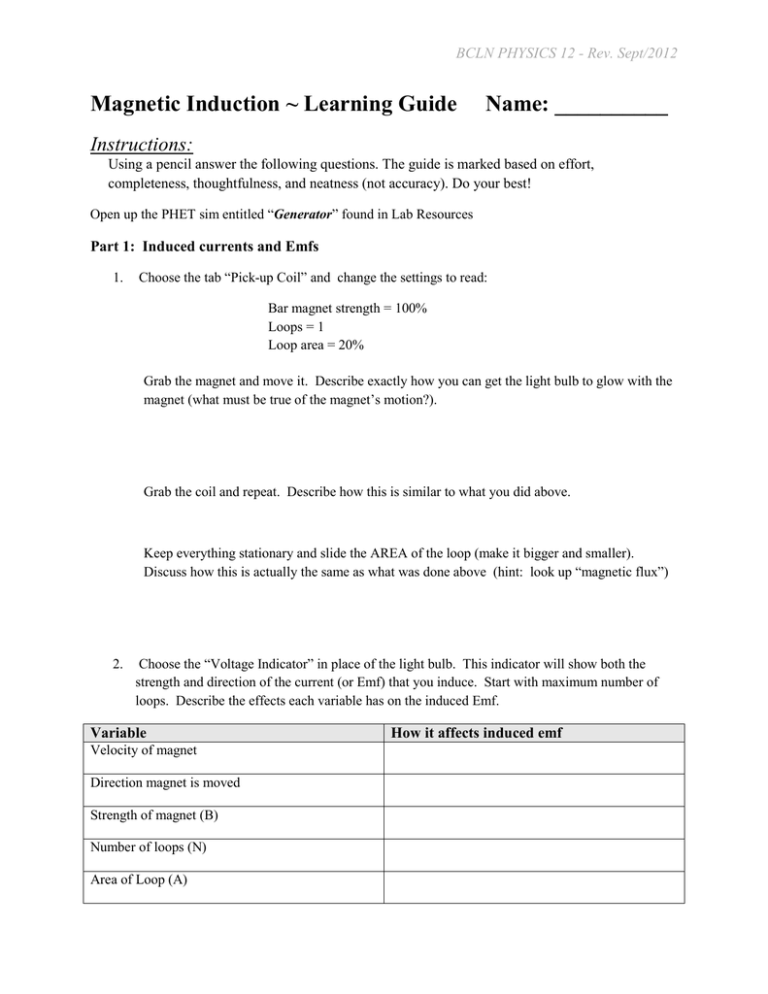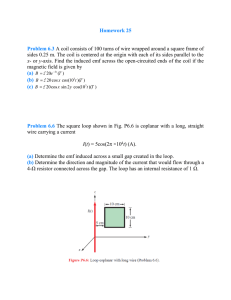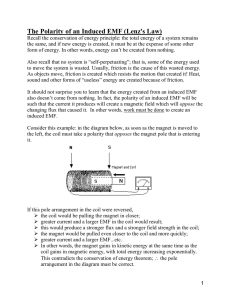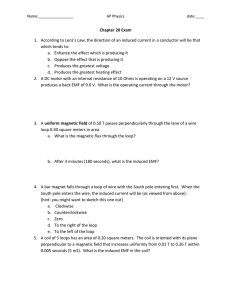Magnetic Induction ~ Learning Guide Name
advertisement

BCLN PHYSICS 12 - Rev. Sept/2012 Magnetic Induction ~ Learning Guide Name: __________ Instructions: Using a pencil answer the following questions. The guide is marked based on effort, completeness, thoughtfulness, and neatness (not accuracy). Do your best! Open up the PHET sim entitled “Generator” found in Lab Resources Part 1: Induced currents and Emfs 1. Choose the tab “Pick-up Coil” and change the settings to read: Bar magnet strength = 100% Loops = 1 Loop area = 20% Grab the magnet and move it. Describe exactly how you can get the light bulb to glow with the magnet (what must be true of the magnet’s motion?). Grab the coil and repeat. Describe how this is similar to what you did above. Keep everything stationary and slide the AREA of the loop (make it bigger and smaller). Discuss how this is actually the same as what was done above (hint: look up “magnetic flux”) 2. Choose the “Voltage Indicator” in place of the light bulb. This indicator will show both the strength and direction of the current (or Emf) that you induce. Start with maximum number of loops. Describe the effects each variable has on the induced Emf. Variable Velocity of magnet Direction magnet is moved Strength of magnet (B) Number of loops (N) Area of Loop (A) How it affects induced emf BCLN PHYSICS 12 - Rev. Sept/2012 3. Move one pole of a bar magnet into the center of the solenoid and leave it there. Note what happens to the galvanometer. Remove the bar magnet from the solenoid and note the effect on the galvanometer. Results ______________ ___________________ ___________________ Predict what will happen if you use the other pole of the magnet. Prediction____________ ___________________ ___________________ Test your prediction and note the results. Results ______________ ___________________ ___________________ What can you say about the relationship between magnetic fields and current? 4. Describe what is meant by the term “Magnetic Flux” (define units as well). What is the formula to determine magnetic flux? Discuss which variables must be parallel or perpendicular to each other and use a diagram to help explain your variables. 5. Describe how magnetic flux and induced Emf are related (questions 2 and 3 above). In other words, what must be true of the magnetic flux to induce an emf? BCLN PHYSICS 12 - Rev. Sept/2012 6. Determine if the situations below will produce a change in the magnetic flux and if so, give the value of ΔΦ and the emf induced. The coil consists of 7 loops, each with area of 0.55 m2. The magnetic field strength is 0.60 T. The time for each change is 0.10 s. Coil is moved to a region of B=0.60 T to 0 T Coil is moved and stays in B field m ov e m e nt of coil m ov e m e nt of coil Ans: ΔΦ = -0.33 Wb, ε = 23.1 V Ans: ΔΦ = 0 Wb, ε = 0 V (be sure to state why) Ans: ΔΦ = -0.33 Wb, ε = 23.1 V Ans: ΔΦ = 0 Wb, ε = 0 V (be sure to state why) Coil is rotated from position shown by 90o Coil is rotated from position shown by 180o 7. A coil has 20 turns each with an area of 1.5 x 10-3 m2. A magnetic field is perpendicular to the surface at all times. The field increases from 0.5T to 0.6T over a 0.10 second time period. Find i. The initial flux through the coil. (ans: 7.5x10-4 Wb) ii. The induced emf. (ans: -0.03 V) BCLN PHYSICS 12 - Rev. Sept/2012 iii. The induced emf if the change is reversed and the field is raised back to its original over the same period of time. (ans: +0.03 V) 8. A flat coil of wire (0.1m by 0.2m) has 50 turns. At t=0, the coil is perpendicular to a magnetic field B = 0.18T, (its normal is parallel to the direction of the field). The coil is rotated 30° over a period of 0.1 seconds. i. What is the induced emf? (ans: 0.24 V) ii. What would the emf be if the coil is now rotated from this position to 90° ? (ans: 1.56 V) 9. A wire is oriented into a loop that has a diameter of 1 cm. This loop is then pulled closed in 0.5 s. If there was a magnetic field directed through the loop of 0.25 T, what emf is induced? (ans: 3.9x10-5 V) 10. Define Lenz’s Law in your own words. How is this similar to Newton’s Third Law of motion? BCLN PHYSICS 12 - Rev. Sept/2012 11. For each situation below determine the direction of the induced current in the loop (if there is one). In each case the multiple-choice part is worth one point, and the justification is worth two points. i. A square loop is moving at a constant velocity to the right through a uniform magnetic field that is directed into the page and which extends out of the picture to the left and right. In which direction is the induced current in the loop? ii. A circular loop is at rest in a magnetic field directed into the page. The magnetic field is increasing in magnitude. In which direction is the induced current in the loop? BCLN PHYSICS 12 - Rev. Sept/2012 iii. A piece of wire is wrapped into a loop and placed in a uniform magnetic field that is directed into the page. You then pull on the ends of the wire so the area of the loop is decreasing. In which direction is the induced current in the loop? iv. A bar magnet is held near the center of a wire loop. The magnet is then pulled away from the loop. The north pole is always closest to the loop. In which direction is the induced current in the loop? 12. Two identical square wire loops are placed near a long straight wire that has a current directed to the right. i. Sketch a graph showing how the magnitude of the magnetic field produced by the current in the long straight wire changes as a function of r, the distance from the wire. BCLN PHYSICS 12 - Rev. Sept/2012 ii. In what direction is the induced current (if there is one) in loop 1 if … a. loop 1 remains at rest and the current in the long straight wire is constant? b. loop 1 remains at rest and the current in the long straight wire is increasing in magnitude? c. the current in the long straight wire is constant and loop 1 moves toward the wire? iii. At the instant shown in the diagram above, loop 1 and loop 2 are the same distance from the wire, with loop 1 moving at a speed v directly toward the wire and loop 2 moving at a speed v in a direction 60° to the velocity of loop 1. Which loop has a larger induced current? Justify iv. Returning to the situation described above, with what speed would loop 1 have to move toward the wire to have exactly the same induced current as loop 2, if loop 2 has a speed v in the direction shown? BCLN PHYSICS 12 - Rev. Sept/2012 13. In a Faraday’s Law experiment, a magnet is dropped from rest. As shown in the diagram, the north pole of the magnet is at the bottom of the magnet and the south pole is at the top. The magnet accelerates down, passing through the center of a loop of wire connected to a voltmeter. Assume that the magnet is always oriented as shown in the diagram, with the south pole at the top of the magnet and the north pole at the bottom. i. Let us define positive flux as coming from magnetic field lines that are directed up through the loop. Circle the graph below that best represents the graph of magnetic flux as a function of time for the magnet passing through the loop. Label axis on the correct graph ii. Which graph would represent induced Emf as a function of time? Label axis on the correct graph. Assume downward through the voltmeter is positive. iii. If the magnet is released from rest from a point higher above the loop than it was in part (a), what happens to the height of the peak(s) in the flux vs. time graph? The height of the peak(s) is: [ ] increased [ ] decreased [ ] unchanged BCLN PHYSICS 12 - Rev. Sept/2012 iv. The two pictures below show two possibilities for the current induced in the loop as the magnet falls through the loop. As the magnet falls, what is the direction of the induced current in the loop? [ ] as shown in “Case 1” the entire time [ ] as shown in “Case 2” the entire time [ ] as in “Case 1” initially, then “Case 2” after the magnet has passed through the loop [ ] as in “Case 2” initially, then “Case 1” after the magnet has passed through the loop v. Where is the center of the magnet when the induced current in the loop reaches its first peak magnitude? [ ] above the loop [ ] below the loop [ ] at the center of the loop 14. Emf can be induced in a moving conductor: Examine the diagram below. It shows a conductor (a rod) moving across a set of metal rails at a velocity, v. i. Describe how this generates an emf using our rules that relates magnetic flux to emf. ii. Use Lenz’s Law to determine the direction of the induced current in this circuit. Draw onto the diagram above. BCLN PHYSICS 12 - Rev. Sept/2012 iii. Use the right hand rule to determine the direction of the force acting on the rod as a result of this induced current. Discuss why this answer makes sense according to the laws of physics (it may be easier to discuss why a force in the opposite direction would not make sense) iv. What formula(s) are appropriate to determine the induced emf in the rod. Describe the variables. Discuss what must be parallel or perpendicular. v. An airplane travelling at 278 m/s upward at an angle of 30 o to the horizontal is in a region where earth's magnetic field is 5.0 x 10-5 T upward (vertical field from the ground to the sky). What is the potential difference induced between the wing tips that are 80 m apart? (ans: ε = 0.96 V) BCLN PHYSICS 12 - Rev. Sept/2012 15. A 2cm by 2cm square coil is in a 1.0 T magnetic field as shown below. The coil is pulled out of the field with a constant velocity of 2 m/s. i. At what point is an emf induced? Why? (ans: once it starts to leave the field) ii. What is the value of the induced emf? (ans: -0.04 V) iii. What is the direction of the induced current in the loop? (ans: ccw) 16. In the diagram below the length of the moving conductor L=0.25m (you may assume that this is the distance from “rail to rail”). The strength of the magnetic field is 0.25T. If you need 1.5V of induced emf to light the bulb, and the maximum distance the bar can move is 1m, how much time must the bar be moved and with what velocity must it be moved? (ans: 0.042 s) BCLN PHYSICS 12 - Rev. Sept/2012 Part 2: Faraday’s Law (Transformer) – Use PHET Sim Click on the tab “Transformer” 1. Describe the similarities between this set up and the previous one. In particular talk about how you use this to induce an emf in the secondary coil (the one with the light bulb). 2. Describe how you can induce an emf with the battery alone. What must you do to keep the bulb lit? 3. Describe how inducing an emf in question 2 is, in fact, the same as in question 1. What, exactly, is the criteria for inducing an emf? 4. Have a look at some of the options on the right hand side. What can you select to continuously light the bulb without constantly using the mouse? Describe why this works. BCLN PHYSICS 12 - Rev. Sept/2012 5. Using the diagram below summarize Faraday's experiment. What did he observe i. When the switch is first closed? ii. When the switch remains closed? iii. When the switch is opened? iv. When the switch remains open? BCLN PHYSICS 12 - Rev. Sept/2012 6. We have a long wire with a varying current, I, as indicated in the graph below. Near this wire is a square loop, also shown in the diagram below. Rank the magnitude of the induced current, i, in the square loop from greatest to least for the different time intervals Greatest 1_________ 2__________ 3__________ 4__________ 5__________ Least Please carefully explain your reasoning BCLN PHYSICS 12 - Rev. Sept/2012 Part 3: Generator – Use Phet Sim 1. Click on the “Generator” and describe how a generator works by relating it to what you have learned so far. Be sure to mention induced emf and flux. 2. Discuss the similarities and differences between a generator and a motor. 3. Does the output voltage of a generator increase if it is made to spin faster? Defend your answer with the appropriate equation. 4. Discuss why a generator produces ac current (alternating). How are brushes or commutators used to create dc current? BCLN PHYSICS 12 - Rev. Sept/2012 5. Refer to the diagrams on the left to answer the questions on the right. BCLN PHYSICS 12 - Rev. Sept/2012 Back Emf: 1. What is back emf and how does its presence confirm our conservation of energy law? 2. Electric saws operating at normal speeds draw relatively small amounts of current. But if a piece of wood gets jammed in the blade the saw is prevented from turning and overheats. Why? 3. The armature windings of a dc motor have a resistance of 5.0 Ω. The motor is connected to a 120 V line and when the motor reaches full speed against its normal load, the counter emf is 108 V. Calculate: i. the current into the motor when it is just starting up. Be sure to draw the equivalent circuit showing your motor as a resistor, the battery, and the back emf (another battery) if it exists. (ans: 24 A) ii. the current when the motor reaches full speed. Be sure to draw the equivalent circuit showing your motor as a resistor, the battery, and the back emf (another battery) if it exists. (ans: 2.4 A) BCLN PHYSICS 12 - Rev. Sept/2012 Transformers: 1. Draw a sketch of a typical transformer and label the primary side and the secondary side. i. What must be true if the transformer above is said to be a step-up transformer? Stepdown? ii. In an ideal transformer (no losses) the input power (primary) is equal to the output power (secondary). What major law of physics would be broken if this were not true? iii. Use the above definition to derive the transformer equation that relates Voltages and Currents on both sides. Recall that energy is related to Power. 2. Why can’t a transformer work with the primary voltage set as a dc battery? BCLN PHYSICS 12 - Rev. Sept/2012 3. A transformer for a transistor radio reduces 120 V ac to 9.0 V ac. The secondary contains 30 turns and the radio draws 400 mA. Calculate i. the number of turns in the primary (ans: 400 turns) ii. the current in the primary (ans: 0.03 A) iii. the power transformed (ans: 3.6 W) 4. If a transformer is non-ideal, what can be said about the power in compared to the power out? Where does the missing power go?





